Elemental: An Open-Source Wireless Hardware and Software Platform for Building Energy and Indoor Environmental Monitoring and Control
Abstract
1. Introduction
2. Materials and Methods
2.1. Existing Technologies
2.2. Custom PCBs
2.3. Gateway and Backhaul
2.4. Compatibility with Other Devices
3. Software
3.1. Backhaul Firmware
3.2. Elemental Backend
- VerneMQ—MQTT (Message Queuing Telemetry Transport) message broker
- InfluxDB—Timeseries database
- Grafana—Timeseries visualization
- A middleware application to connect all components
3.3. Data Visualization
4. Results and Discussion
4.1. Long-Term Data Collection and Analysis
4.2. Full-Home Monitoring Solution
4.3. Fault and Anomaly Detection and Diagnostics
5. Conclusions
Author Contributions
Funding
Acknowledgments
Conflicts of Interest
References
- ASHRAE. Performance Measurement Protocols for Commercial Buildings; ASHRAE: Atlanta, GA, USA, 2010. [Google Scholar]
- Heinzerling, D.; Schiavon, S.; Webster, T.; Arens, E. Indoor environmental quality assessment models: A literature review and a proposed weighting and classification scheme. Build. Environ. 2013, 70, 210–222. [Google Scholar] [CrossRef]
- Ahmad, M.W.; Mourshed, M.; Mundow, D.; Sisinni, M.; Rezgui, Y. Building energy metering and environmental monitoring – A state-of-the-art review and directions for future research. Energy Build. 2016, 120, 85–102. [Google Scholar] [CrossRef]
- Ramos, T.; Stephens, B. Tools to improve built environment data collection for indoor microbial ecology investigations. Build. Environ. 2014, 81, 243–257. [Google Scholar] [CrossRef]
- Jia, M.; Komeily, A.; Wang, Y.; Srinivasan, R.S. Adopting Internet of Things for the development of smart buildings: A review of enabling technologies and applications. Autom. Constr. 2019, 101, 111–126. [Google Scholar] [CrossRef]
- Ferdoush, S.; Li, X. Wireless Sensor Network System Design Using Raspberry Pi and Arduino for Environmental Monitoring Applications. Procedia Comput. Sci. 2014, 34, 103–110. [Google Scholar] [CrossRef]
- Karami, M.; McMorrow, G.V.; Wang, L. Continuous monitoring of indoor environmental quality using an Arduino-based data acquisition system. J. Build. Eng. 2018, 19, 412–419. [Google Scholar] [CrossRef]
- Peng, C.; Qian, K.; Wang, C. Design and Application of a VOC-Monitoring System Based on a ZigBee Wireless Sensor Network. IEEE Sens. J. 2015, 15, 2255–2268. [Google Scholar] [CrossRef]
- Abraham, S.; Li, X. Design of A Low-Cost Wireless Indoor Air Quality Sensor Network System. Int. J. Wirel. Inf. Netw. 2016, 23, 57–65. [Google Scholar] [CrossRef]
- Bhunia, S.S.; Roy, S.; Mukherjee, N. IEMS: Indoor environment monitoring system using ZigBee wireless sensor network. In Proceedings of the 2011 International Conference on Communication, Computing & Security—ICCCS ’11, Rourkela, Odisha, India, 12–14 February 2011; ACM Press: Rourkela, Odisha, India, 2011; p. 142. [Google Scholar]
- du Plessis, R.; Kumar, A.; Hancke, G.; Silva, B. A wireless system for indoor air quality monitoring. In Proceedings of the IECON 2016—42nd Annual Conference of the IEEE Industrial Electronics Society, Florence, Italy, 23–26 October 2016; IEEE: Florence, Italy, 2016; pp. 5409–5414. [Google Scholar]
- Kumar, P.; Martani, C.; Morawska, L.; Norford, L.; Choudhary, R.; Bell, M.; Leach, M. Indoor air quality and energy management through real-time sensing in commercial buildings. Energy Build. 2016, 111, 145–153. [Google Scholar] [CrossRef]
- Kumar, P.; Skouloudis, A.N.; Bell, M.; Viana, M.; Carotta, M.C.; Biskos, G.; Morawska, L. Real-time sensors for indoor air monitoring and challenges ahead in deploying them to urban buildings. Sci. Total Environ. 2016, 560–561, 150–159. [Google Scholar] [CrossRef]
- Huang, Y.; Hu, L.; Yang, D.; Liu, H. Air-Sense: Indoor environment monitoring evaluation system based on ZigBee network. IOP Conf. Ser. Earth Environ. Sci. 2017, 81, 012208. [Google Scholar] [CrossRef]
- Kim, J.-J.; Jung, S.K.; Kim, J.T. Wireless Monitoring of Indoor Air Quality by a Sensor Network. Indoor Built Environ. 2010, 19, 145–150. [Google Scholar] [CrossRef]
- Brunelli, D.; Minakov, I.; Passerone, R.; Rossi, M. POVOMON: An Ad-hoc Wireless Sensor Network for indoor environmental monitoring. In Proceedings of the 2014 IEEE Workshop on Environmental, Energy, and Structural Monitoring Systems Proceedings, Naples, Italy, 17–18 September 2014; IEEE: Naples, Italy, 2014; pp. 1–6. [Google Scholar]
- Jang, W.-S.; Healy, W.M.; Skibniewski, M.J. Wireless sensor networks as part of a web-based building environmental monitoring system. Autom. Constr. 2008, 17, 729–736. [Google Scholar] [CrossRef]
- Ali, A.S.; Zanzinger, Z.; Debose, D.; Stephens, B. Open Source Building Science Sensors (OSBSS): A low-cost Arduino-based platform for long-term indoor environmental data collection. Build. Environ. 2016, 100, 114–126. [Google Scholar] [CrossRef]
- Weekly, K.; Jin, M.; Zou, H.; Hsu, C.; Soyza, C.; Bayen, A.; Spanos, C. Building-in-Briefcase: A Rapidly-Deployable Environmental Sensor Suite for the Smart Building. Sensors 2018, 18. [Google Scholar] [CrossRef] [PubMed]
- Minoli, D.; Sohraby, K.; Occhiogrosso, B. IoT Considerations, Requirements, and Architectures for Smart Buildings—Energy Optimization and Next-Generation Building Management Systems. IEEE Internet Things J. 2017, 4, 269–283. [Google Scholar] [CrossRef]
- rosetta-home/rosetta_home. Rosetta Home 2.0 Is an Open Source Building Performance Monitoring Platform. Available online: https://github.com/rosetta-home/rosetta_home (accessed on 21 May 2019).
- Castell, N.; Dauge, F.R.; Schneider, P.; Vogt, M.; Lerner, U.; Fishbain, B.; Broday, D.; Bartonova, A. Can commercial low-cost sensor platforms contribute to air quality monitoring and exposure estimates? Environ. Int. 2017, 99, 293–302. [Google Scholar] [CrossRef] [PubMed]
- Bamodu, O.; Xia, L.; Tang, L. An indoor environment monitoring system using low-cost sensor network. Energy Procedia 2017, 141, 660–666. [Google Scholar] [CrossRef]
- Bagula, A.; Zennaro, M.; Inggs, G.; Scott, S.; Gascon, D. Ubiquitous Sensor Networking for Development (USN4D): An Application to Pollution Monitoring. Sensors 2012, 12, 391–414. [Google Scholar] [CrossRef]
- Salamone, F.; Belussi, L.; Danza, L.; Ghellere, M.; Meroni, I. Design and Development of nEMoS, an All-in-One, Low-Cost, Web-Connected and 3D-Printed Device for Environmental Analysis. Sensors 2015, 15, 13012–13027. [Google Scholar] [CrossRef]
- Camprodon, G.; González, Ó.; Barberán, V.; Pérez, M.; Smári, V.; de Heras, M.Á.; Bizzotto, A. Smart Citizen Kit and Station: An open environmental monitoring system for citizen participation and scientific experimentation. HardwareX 2019, 6, e00070. [Google Scholar] [CrossRef]
- Pocero, L.; Amaxilatis, D.; Mylonas, G.; Chatzigiannakis, I. Open source IoT meter devices for smart and energy-efficient school buildings. HardwareX 2017, 1, 54–67. [Google Scholar] [CrossRef]
- Trilles, S.; Luján, A.; Belmonte, Ó.; Montoliu, R.; Torres-Sospedra, J.; Huerta, J. SEnviro: A Sensorized Platform Proposal Using Open Hardware and Open Standards. Sensors 2015, 15, 5555–5582. [Google Scholar] [CrossRef] [PubMed]
- Rusu, F. Wireless Programming Library and Example Code for Moteino: LowPowerLab/WirelessProgramming; LowPowerLab, LLC: Canton, MI, USA, 2019. [Google Scholar]
- ProQuest. Open Source Building Science Sensors (OSBSS): A Low-Cost Arduino-Based Platform for Long-Term Data Collection in Indoor Environments. Available online: https://search.proquest.com/openview/3f389675a54bfc 30a817aecf6970cee2/ (accessed on 14 September 2019).
- Zheng, T.; H. Bergin, M.; Johnson, K.; Tripathi, S.; Shirodkar, S.; Landis, M.; Sutaria, R.; E. Carlson, D. Field evaluation of low-cost particulate matter sensors in high- and low-concentration environments. Atmospheric Meas. Tech. 2018, 11, 4823–4846. [Google Scholar] [CrossRef]
- HOPE Microelectronics. RFM69W,RF Transceiver: FSK Modulation. Available online: http://www.hoperf.de/ rf/module/fsk/RFM69W.htm (accessed on 4 June 2019).
- OSH Park. Available online: https://oshpark.com/ (accessed on 1 August 2019).
- Rusu, F. RFM69 library for RFM69W, RFM69HW, RFM69CW, RFM69HCW (Semtech SX1231, SX1231H): LowPowerLab/RFM69; LowPowerLab, LLC: Canton, MI, USA, 2019. [Google Scholar]
- SparkFun Electronics. Pocket AVR Programmer—PGM-09825. Available online: https://www.sparkfun.com/ products/9825 (accessed on 22 July 2019).
- Tag Connect. TC2030-IDC-NL. Available online: http://www.tag-connect.com/node/36 (accessed on 22 July 2019).
- Elemental-Platform. Available online: https://github.com/elemental-platform (accessed on 16 August 2019).
- Smartbedded. Meteostick. Available online: https://www.smartbedded.com/wiki/index.php/Meteostick (accessed on 4 June 2019).
- Nerves Project. Craft and Deploy Bulletproof Embedded Software in Elixir. Available online: https://nerves-project.org/ (accessed on 4 June 2019).
- Enterprise Container Platform | Docker. Available online: https://www.docker.com/ (accessed on 4 June 2019).
- MQTT. Available online: http://mqtt.org/ (accessed on 18 September 2019).
- Chooruang, K.; Mangkalakeeree, P. Wireless Heart Rate Monitoring System Using MQTT. Procedia Comput. Sci. 2016, 86, 160–163. [Google Scholar] [CrossRef]
- Barata, D.; Louzada, G.; Carreiro, A.; Damasceno, A. System of Acquisition, Transmission, Storage and Visualization of Pulse Oximeter and ECG Data Using Android and MQTT. Procedia Technol. 2013, 9, 1265–1272. [Google Scholar] [CrossRef]
- Kashyap, M.; Sharma, V.; Gupta, N. Taking MQTT and NodeMcu to IOT: Communication in Internet of Things. Procedia Comput. Sci. 2018, 132, 1611–1618. [Google Scholar] [CrossRef]
- Company, O.L.A.-T.V. VerneMQ—A MQTT Broker That Is Scalable, Enterprise Ready, and Open Source. Available online: https://vernemq.com/ (accessed on 4 June 2019).
- InfluxData. Scalable Datastore for Metrics, Events, and Real-Time Analytics: Influxdata/Influxdb; InfluxData Inc.: San Francisco, CA, USA, 2019. [Google Scholar]
- Balis, B.; Bubak, M.; Harezlak, D.; Nowakowski, P.; Pawlik, M.; Wilk, B. Towards an operational database for real-time environmental monitoring and early warning systems. Procedia Comput. Sci. 2017, 108, 2250–2259. [Google Scholar] [CrossRef]
- Sun, A.Y.; Zhong, Z.; Jeong, H.; Yang, Q. Building complex event processing capability for intelligent environmental monitoring. Environ. Model. Softw. 2019, 116, 1–6. [Google Scholar] [CrossRef]
- Chen, Y.; Han, D. Water quality monitoring in smart city: A pilot project. Autom. Constr. 2018, 89, 307–316. [Google Scholar] [CrossRef]
- Elm—A Delightful Language for Reliable Webapps. Available online: https://elm-lang.org (accessed on 4 June 2019).
- Grafana—The Open Platform for Analytics and Monitoring. Available online: https://grafana.com (accessed on 4 June 2019).
- Velicka, J.; Pies, M.; Hajovsky, R. Wireless Measurement of Carbon Dioxide by use of IQRF Technology. IFAC-Pap. 2018, 51, 78–83. [Google Scholar] [CrossRef]
- Min, K.T.; Lundrigan, P.; Sward, K.; Collingwood, S.C.; Patwari, N. Smart home air filtering system: A randomized controlled trial for performance evaluation. Smart Health 2018, 9–10, 62–75. [Google Scholar] [CrossRef]
- Almeida, F.; Assunção, M.D.; Barbosa, J.; Blanco, V.; Brandic, I.; Da Costa, G.; Dolz, M.F.; Elster, A.C.; Jarus, M.; Karatza, H.D.; et al. Energy monitoring as an essential building block towards sustainable ultrascale systems. Sustain. Comput. Inform. Syst. 2018, 17, 27–42. [Google Scholar] [CrossRef]
- Wallace, L.A.; Emmerich, S.J.; Howard-Reed, C. Continuous measurements of air change rates in an occupied house for 1 year: The effect of temperature, wind, fans, and windows*. J. Expo. Sci. Environ. Epidemiol. 2002, 12, 296–306. [Google Scholar] [CrossRef] [PubMed]
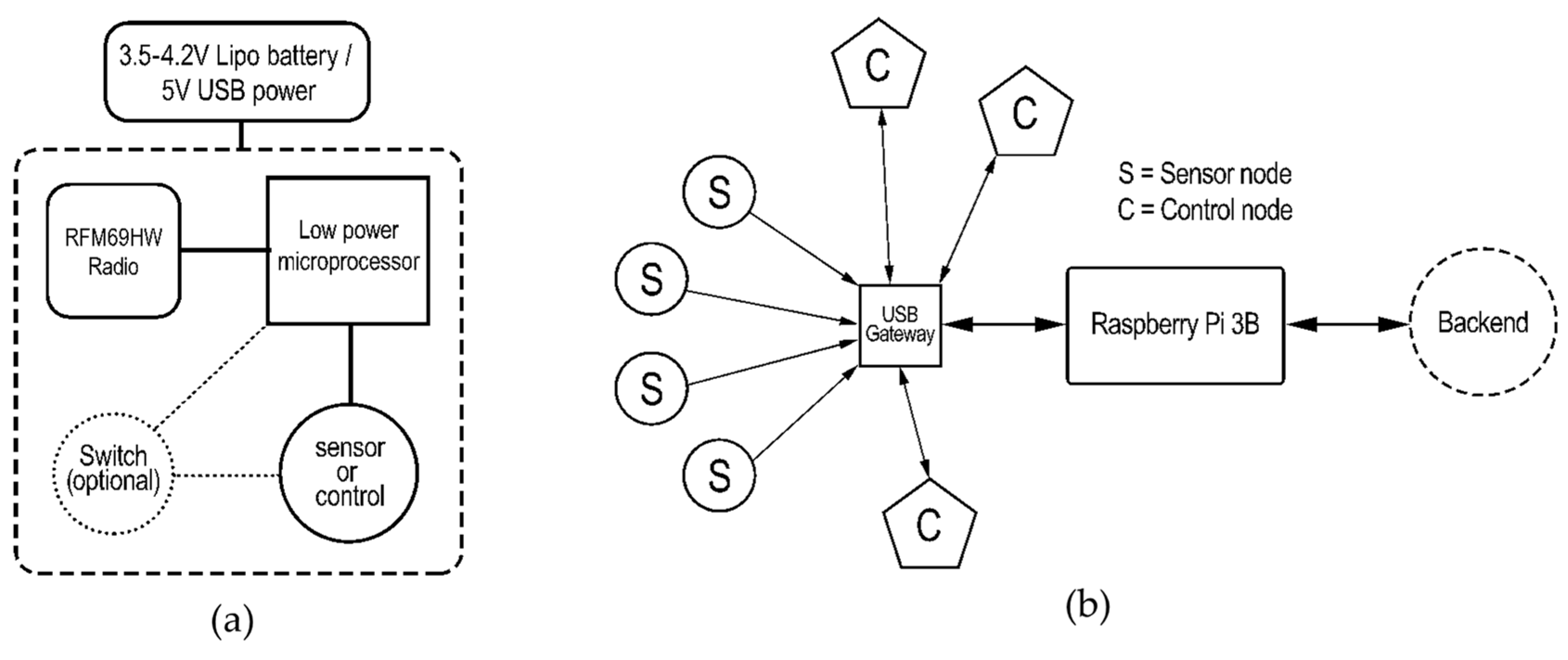

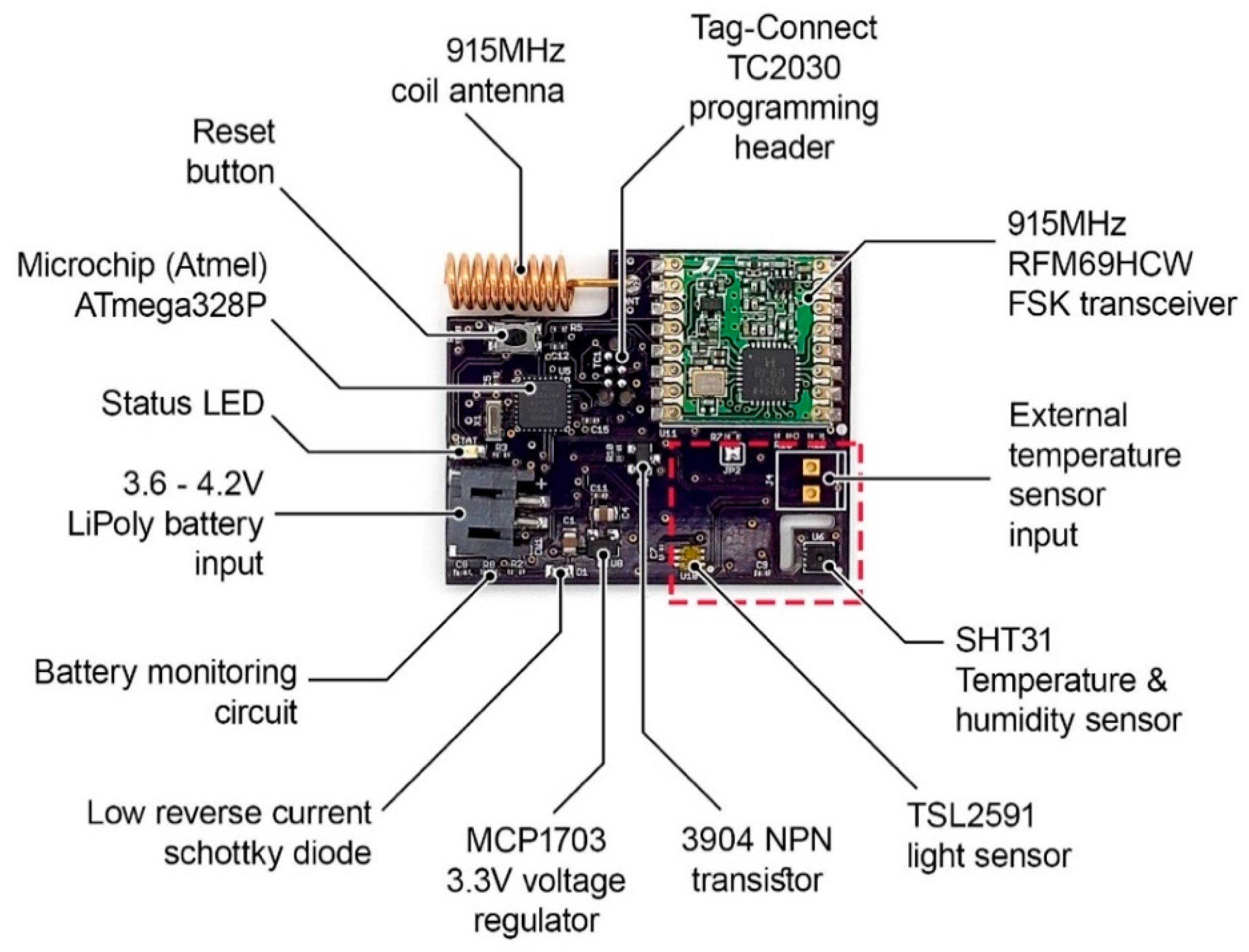
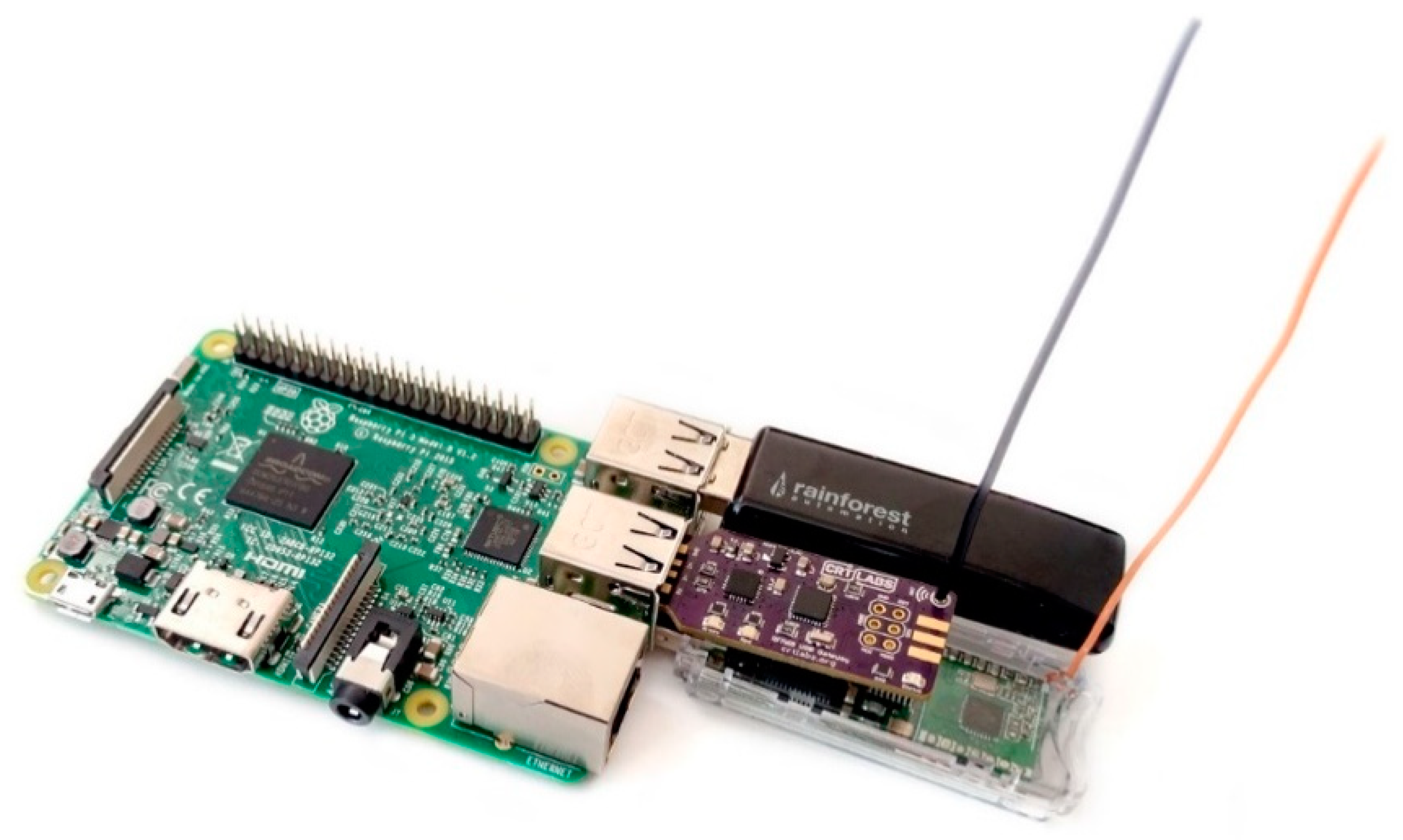
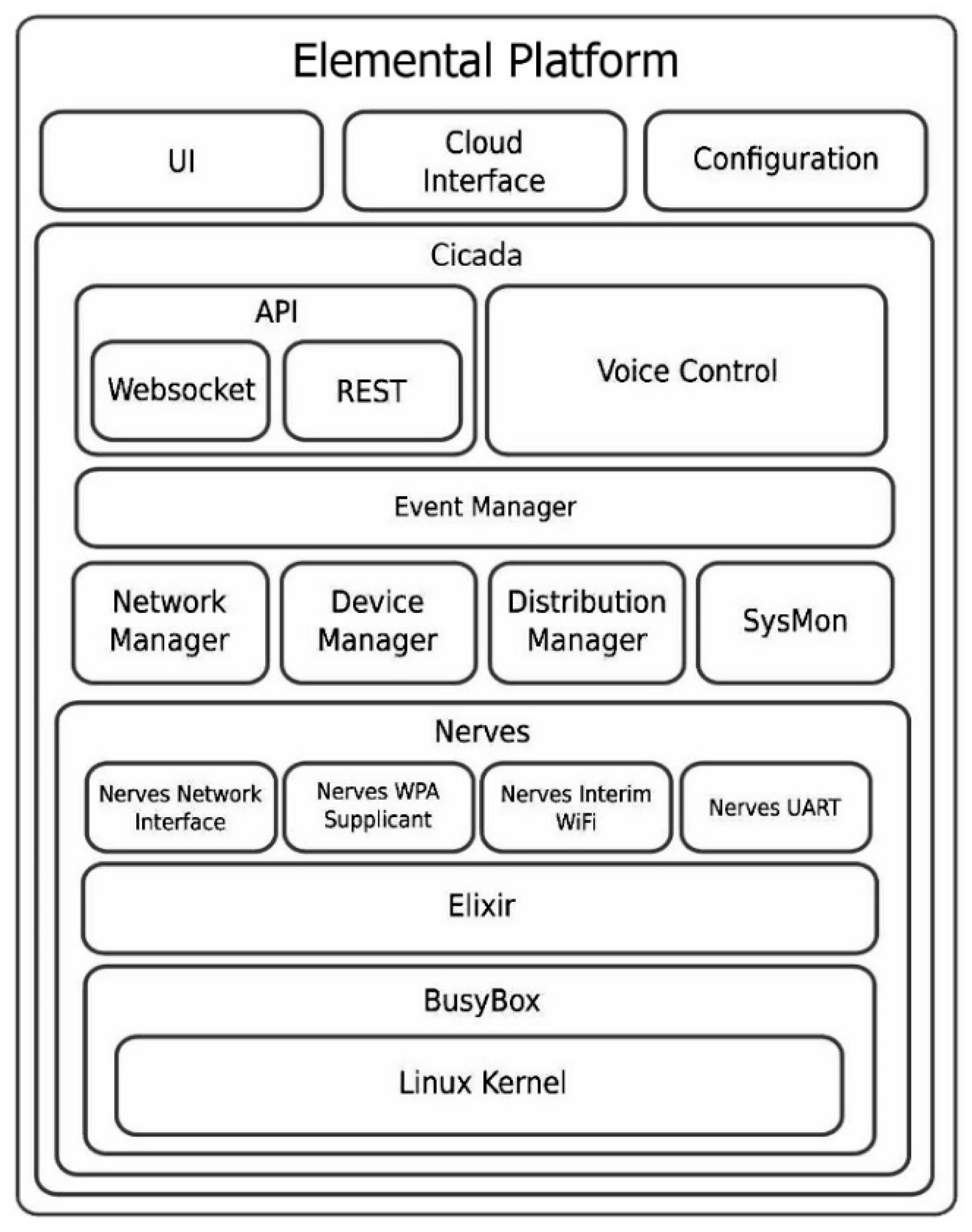
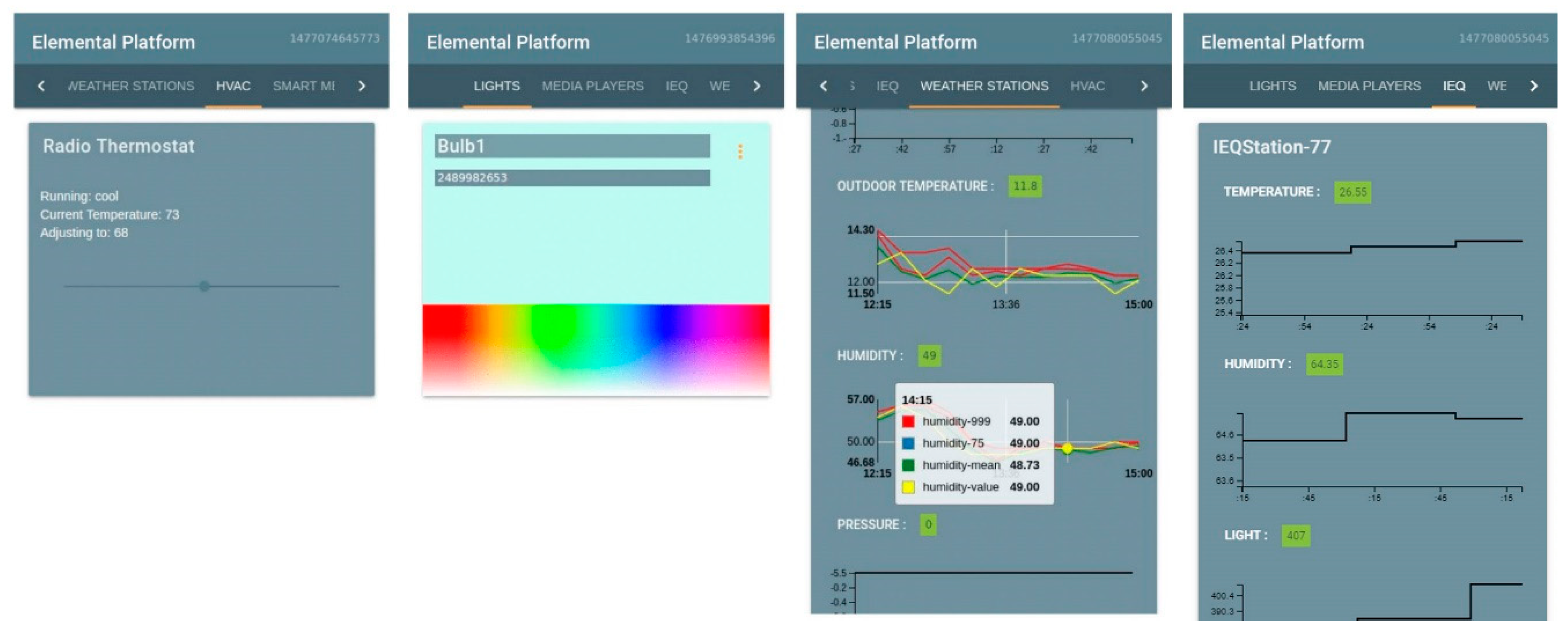
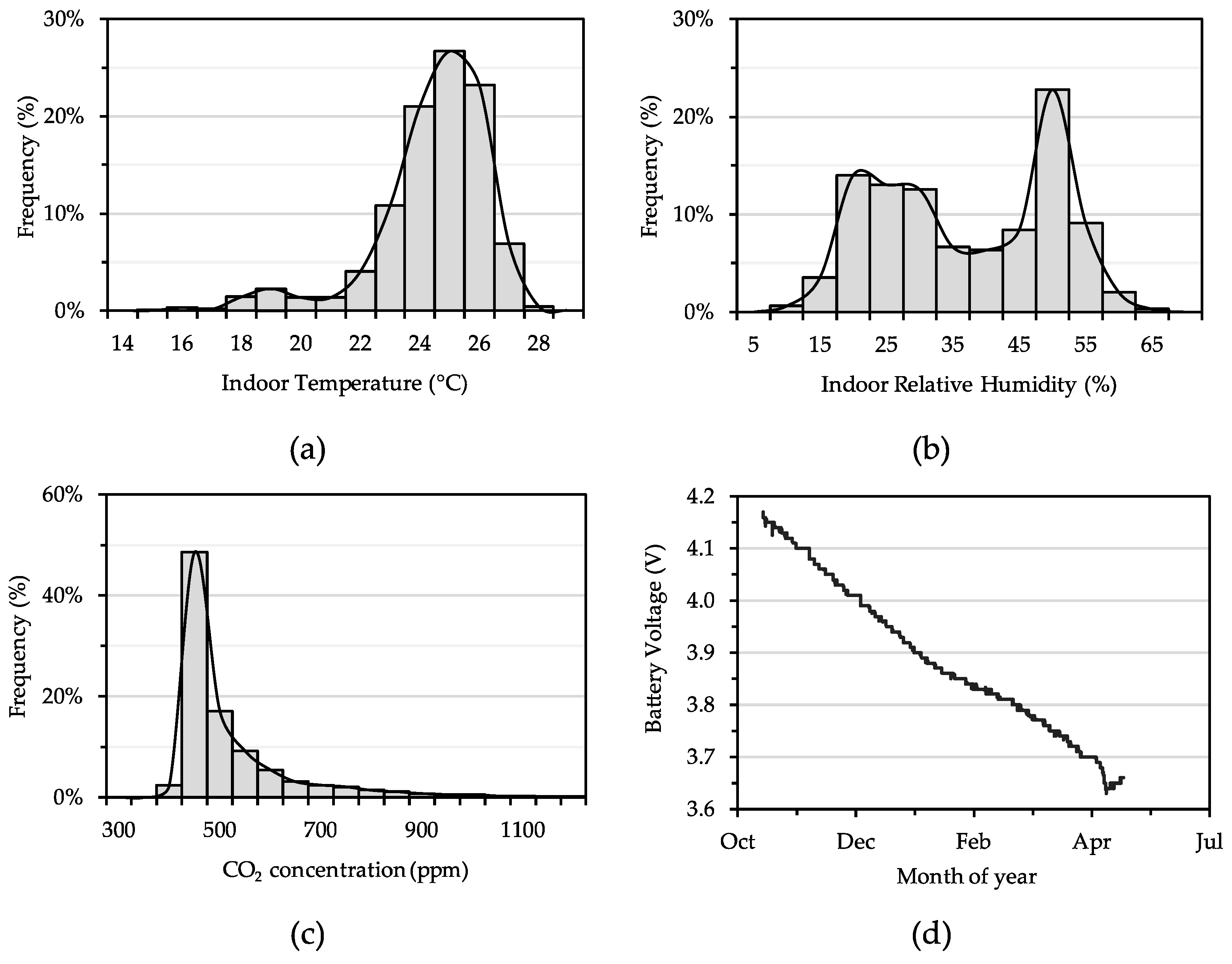


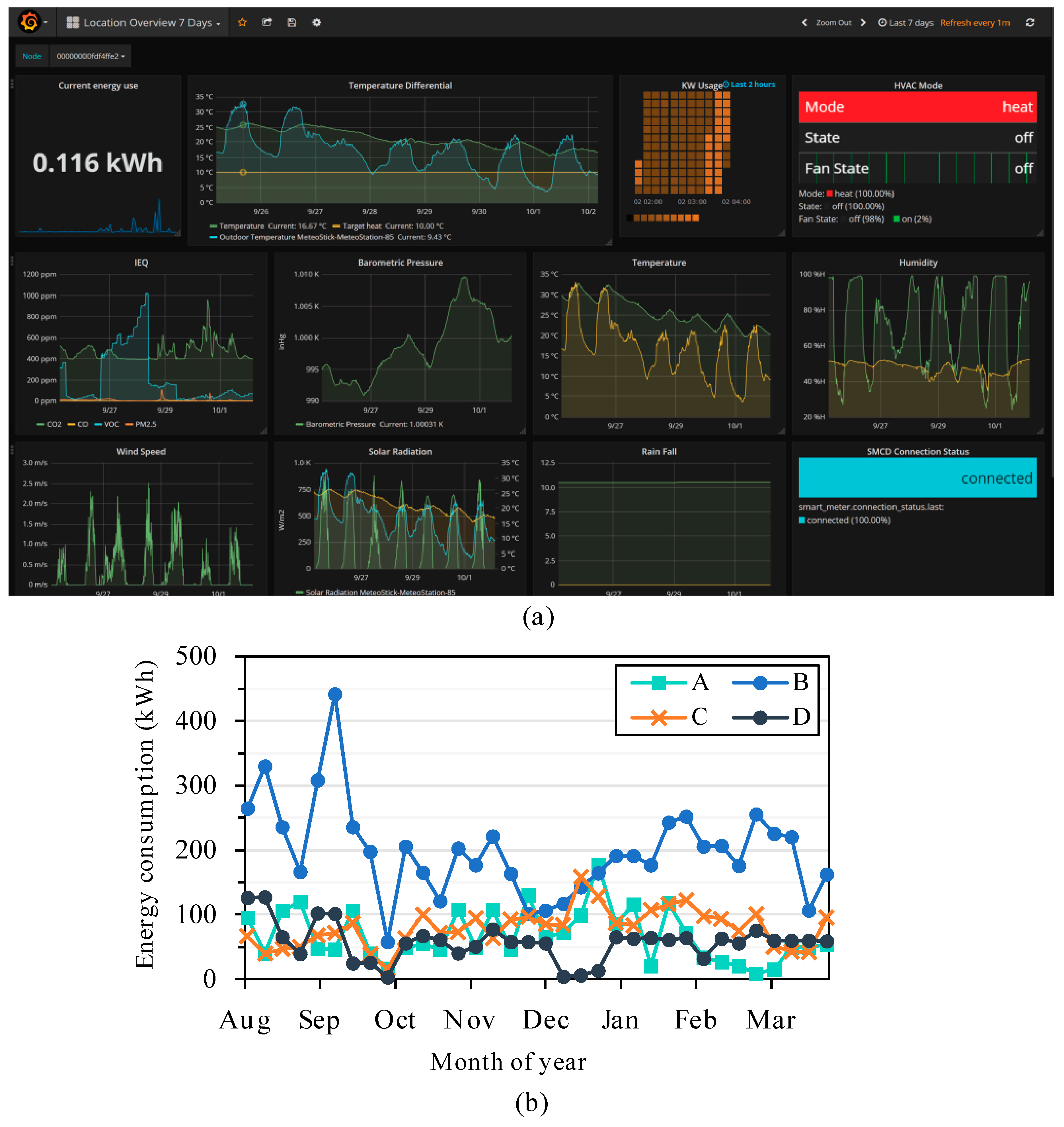
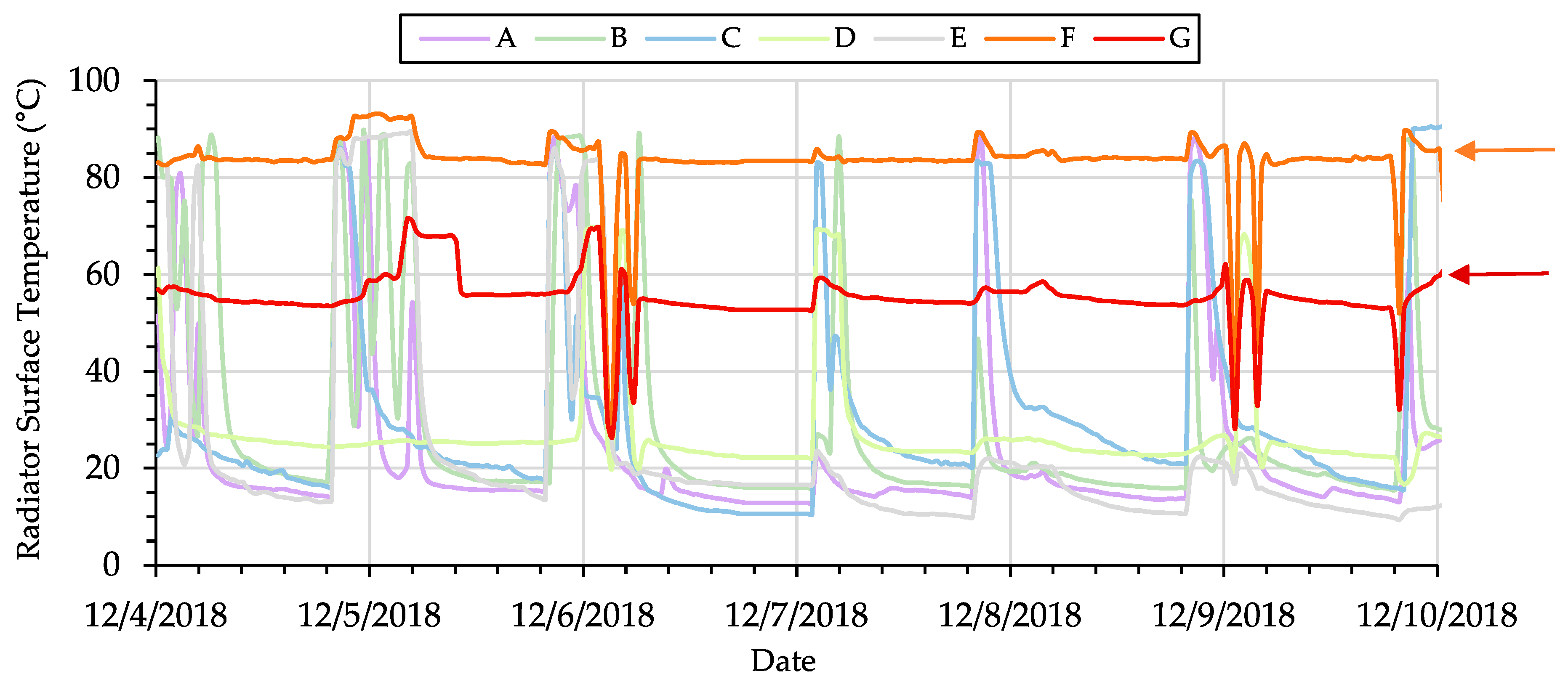
| Components | Part Number | Unit Cost (USD) |
|---|---|---|
| Common parts | ||
| Microprocessor | Microchip ATmega328P | $2 |
| Voltage regulator | MCP1703-3.3 V | $0.50 |
| Radio | RFM69HCW-915 FSK Transceiver | $4 |
| Switch | MMBT3904 NPN transistor | $0.10 |
| Battery | Lithium-Ion polymer (1200 mAh) | $5 |
| Sensors | ||
| Temperature & humidity | Sensirion SHT31 | $6 |
| Light | AMS TSL2591 | $2 |
| Motion | Parallax mini PIR sensor | $10 |
| Door/Window opening | Soway NO Reed switch | $0.50 |
| Carbon Dioxide | SenseAir S8 | $85 |
| TVOC | Sensirion SGP30 | $12 |
| PM2.5 and PM10 | Plantower PMS7003 | $15 |
| Barometric Pressure | Bosch BMP388 | $3 |
| Surface temperature | US sensors PR103J2 precision thermistor | $6 |
| Other components | ||
| USB interface | FTDI FT231XQ USB 2.0 full speed IC | $2 |
| Flash memory | Windbond 4mbit W25 × 40CLSNIG | $0.40 |
| Coil antenna | 915 MHz helical coil antenna | $0.10 |
| Rubber ducky antenna | 915 MHz 3dBi SMA antenna | $2.50 |
| Board Type | Unit Cost (USD) |
|---|---|
| Elemental wireless sensor boards | |
| Temperature, relative humidity, light intensity node | $15 |
| Occupancy/motion node | $20 |
| Door/window node | $10 |
| CO2 concentration node | $40 |
| All-in-one IAQ node | $85 |
| Wireless USB Gateway | $10 |
| Backhaul (including supported USB gateways) | |
| Raspberry Pi 3B+ | $35 |
| Rainforest Automation RAVEn USB adapter | $40 |
| Smartbedded Meteostick | $178 |
| Name | Unit Cost (USD) | Total Kit Cost (USD) | |
|---|---|---|---|
| Sensor | Gateway | ||
| Onset HOBO ZW Series wireless monitoring kit (3 sensors, 1 gateway) | $274 | $219 | $989 |
| Monnit Wi-Fi temperature monitoring bundle (3 sensors) | $159 | - | $487 |
| TempGenius complete 5 sensor system | - | - | $1,899 |
| Lascar EL-WiFi-TH-Plus (3 sensors) | $200 | - | $600 |
| Elemental wireless T/RH/Light 5 sensor kit | $15 | $45 | $120 |
© 2019 by the authors. Licensee MDPI, Basel, Switzerland. This article is an open access article distributed under the terms and conditions of the Creative Commons Attribution (CC BY) license (http://creativecommons.org/licenses/by/4.0/).
Share and Cite
Ali, A.S.; Coté, C.; Heidarinejad, M.; Stephens, B. Elemental: An Open-Source Wireless Hardware and Software Platform for Building Energy and Indoor Environmental Monitoring and Control. Sensors 2019, 19, 4017. https://doi.org/10.3390/s19184017
Ali AS, Coté C, Heidarinejad M, Stephens B. Elemental: An Open-Source Wireless Hardware and Software Platform for Building Energy and Indoor Environmental Monitoring and Control. Sensors. 2019; 19(18):4017. https://doi.org/10.3390/s19184017
Chicago/Turabian StyleAli, Akram Syed, Christopher Coté, Mohammad Heidarinejad, and Brent Stephens. 2019. "Elemental: An Open-Source Wireless Hardware and Software Platform for Building Energy and Indoor Environmental Monitoring and Control" Sensors 19, no. 18: 4017. https://doi.org/10.3390/s19184017
APA StyleAli, A. S., Coté, C., Heidarinejad, M., & Stephens, B. (2019). Elemental: An Open-Source Wireless Hardware and Software Platform for Building Energy and Indoor Environmental Monitoring and Control. Sensors, 19(18), 4017. https://doi.org/10.3390/s19184017






